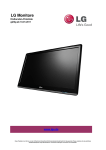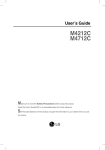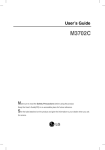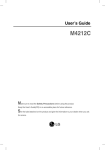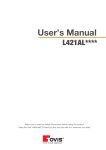Download LG M3800S-BN
Transcript
User’s Guide M2900S M3800S Make sure to read the Safety Precautions before using the product. Keep the User's Guide(CD) in an accessible place for future reference. See the label attached on the product and give the information to your dealer when you ask for service. Using the Remote Control Name of the Remote Control Buttons • Power On/Off Button • Source Button Select input source (RGB, DVI) SOURCE • Auto Button Automatic adjustment function (Operational for the analog signal only) MENU • buttons OSD Menu Navigation buttons • Select OSD Menu Item. : Decrement Value : Increment Value • Menu Button OSD On/ Off Sub OSD Menu out ZOOM • button Zoom Hot key (Normal Zoom Full) * Only OSD menu off Inserting batteries into remote control. CR2025 1. Slide off the battery cover. 2. Insert the batteries with correct polarity (+/-). 3. Close the battery cover. • Dispose of used batteries in the recycle bin to prevent environmental pollution. 1 Name and Function of the Parts * The product image in the user’s guide could be different from the actual image. Rear View DVI IN RGB IN RS-32C IN DVI, RGB Ports RS-232C Serial Port Wired Remote Control Port Power Connector : Connect the power cord 2 REMOTE CONTROL IN AC-IN Connecting to External Devices When Connecting to your PC First of all, see if the computer, product and the peripherals are turned off. Then, connect the signal input cable. A When connecting with the D-Sub signal input cable. (RGB) RGB IN PC Rear side of the product. B When connecting with the DVI signal input cable. DVI IN PC Rear side of the product. Connect the power cord. Rear side of the product. 3 Connecting to External Devices 1 Turn on power by pressing the power button on the product. SOURCE ON/OFF Zoom Power button 2 Turn on the PC. To change input source Press the SOURCE button on the remote control to select the input signal. Or, press the SOURCE button on the bottom of the product. DVI signal Note D-Sub signal • How to connect to two computers. Connect the signal cables (DVI and D-Sub) to each computer. Press the SOURCE button on the remote control to select the computer to use. • Directly connect to a grounded power outlet or power strip (three prong connector.) 4 Connecting to External Devices VESA FDMI wall Mounting This product supports a VESA FDMI compliant mounting interface. These mounts are purchaed separately and not available from LG. Refer to the instructions included with hte mount for more info. 5 User Menus Screen Adjustment options SOURCE ON/OFF Zoom Power Button • Press this button to turn on the power. Press this button again to turn it off. Power Indicator • This Indicator lights up green when the display operates normally(on mode). If the display is in sleep (Energy Saving) mode, this indicator color changes to amber. MENU Button • Use this button to show/hide the OSD (On Screen Display) menu screen. OSD Select / Adjust Button • Use this button to select an icon or adjust the setting in the OSD screen. OSD Menu Navigation up and down : Zoom Hot key (Normal Zoom Full) Zoom : Select Menu Item, Decrement Value : Select Menu Item, Increment Value 6 User Menus Screen Adjustment options SOURCE Button To change input source depending on connected signal. Press the SOURCE button on the remote control to select the input signal. Or, press the SOURCE button on the bottom of the product. IR Receiver DVI signal D-Sub signal Digital signal 15-pin D-Sub analog signal • This is where the unit receives signals from the remote control. 7 User Menus OSD Menu Icon Function Description Adjusts screen brightness, contrast and color that you prefer. PICTURE Adjusts the screen size. ZOOM Adjusts the timer options. TIMER Adjusts the OSD image. OSD Note OSD(On Screen Display) The OSD function enables you to adjust the screen status conveniently since it provides graphical presentation. 8 User Menus How to adjust the OSD (On Screen Display) screen MENU Pops up the menu screen MENU Move where you want to adjust Select a menu icon Move where you want to adjust Select a menu icon Adjust the status Save adjustment MENU Exit from the menu screen. • Use the remote control to adjust the OSD screen. 1 Press the MENU Button, then the main menu of the OSD appears. 2 To access a control, use the 3 When the icon you want becomes highlighted, press the 4 Use the 5 Accept the changes by pressing the MENU Button. 6 Exit the OSD by pressing the MENU Button. Buttons. Button. Buttons to adjust the item to the desired level. How to adjust the screen automatically Press the AUTO button on a remote Control in the PC analog signal. Then optimal screen settings will be selected that fit into the current mode. If adjustment is not satisfactory, you can adjust the screen manually. 9 Auto-Adjust User Menus Adjusting Screen Color PICTURE Contrast Brightness Color Temp. Cool H- Position V-Position Clock Phase Auto Adjust Move Select MENU Exit Contrast Brightness Adjust the difference between the light and dark levels in the picture. To adjust the brightness of the screen. Color Temp Color Settings PICTURE Contrast Brightness Color Temp. Cool H- Position V-Position Clock Phase Auto Adjust Move Select MENU Exit • Cool : Slightly purplish white. • Normal : Slightly bluish white. • Warm : Slightly reddish white. • User : Select this option to use the user-defined settings. 10 User Menus Adjusting Screen Color PICTURE Color Temp. Cool User - R User - G User - B Move Select MENU Exit Red / Green / Blue Set your own color levels. H-Position : Moving the screen position horizontally. V-Position : Moving the screen position vertically. Clock : To minimize any vertical bars or stripes visible on the screen background. The horizontal screen size will also change. This function is available for analog signals only. Phase : To adjust the focus of the display. This item allows you to remove any horizontal noise and clear or sharpen the image of characters. This function is available for analog signals only. Auto Adjust (RGB PC input only) : This button is for the automatic adjustment of the screen position, clock and phase. This function is available for analog signals only. 11 User Menus Adjusting Screen size Resolution ZOOM Resolution 1366X768 Mode Zoom 0 Zoom Fine Move 1. For more improved or better picture quality, select the same mode corresponding to computer resolution. Select MENU Exit ZOOM Press the Resolution button. 1366X768 Setup Mode Move 2. Select MENU Exit ZOOM Press the Resolution 1366X768 Setup Mode Move 3. Select MENU Exit Accept the changes by pressing the 12 Button. button. User Menus Adjusting Screen size Mode Zoom Fine To select the image size of the screen. Normal The aspect ratio is not adjusted from the original. It is set by the program being watched. Full When your AV receives the wide screen signal, it will lead you to adjust the picture horizontally or vertically, in a linear proportion, to fill the entire screen fully. Zoom When an image created based on M2900S model resolution (1366 X 480) and an image based on M3800S model resolution (1366 X 398) are used in different models, this function adjusts an image to fit to the screen size without cutting it or leaving any empty space on screen. To adjust the enlarged or reduced areas on the screen when the product is in Zoom mode. 13 User Menus Adjusting the timer function TIMER Clock 02:02 On Time 06:30 Off Time 22:00 Function OFF Move Select MENU Exit Clock If the current time is incorrect, reset the clock manually. 1) Press the MENU button and then use button to select the TIMER menu. 2) Press the button and then use button to select the Clock menu. 3) Press the button and then use button to set the hour(00~23). 4) Press the button and then use button to set the minutes(00~59). 5) Press the MENU button. On/ Off Time The off time automatically switches the set to standby at the pre-set time. button to select the TIMER menu. 1) Press the MENU button and then use 2) Press the button and then use button to select Off Time or On Time. 3) Press the button and then use button to set the hour(00~23). 4) Press the button and then use button to set the minutes(00~59). 5) Press the MENU button. Function To set automatic On/Off. On : Automatically turn the product On/Off at preset times. Off : Disable the On/Off Time function. Note In the event of power interruption (disconnection or power failure), the clock must be reset. Once the on or off time is set, these functions operate daily at the preset time. Off time function overrides On time function if they are set to the same time. When On time is operated, input screen is turned on as it was turned off. 14 User Menus Adjusting OSD image OSD OSD Set ID 1 H-Position 3 V-Position 10 On-Screen Time 10 Halftone 63 Factory Reset Move Select MENU Exit Set ID You can assign a unique Set ID NO (name assignment) to each product when several products are connected for display. Specify the button and exit. Use the assigned Set number (1~99) using the ID to individually control each product using the Product Control Program. H-Position Moving the OSD screen position horizontally. V-Position Moving the OSD screen position vertically. On-Screen Time To set the period of time that the OSD is displayed on the screen. (Available times : 3 to 24 second.) Halftone To adjust the transparency of the OSD menu screen. Factory Reset Select this option to return to the default factory settings. 15 Troubleshooting No image is displayed ● Is the product power cord connected? • See if the power cord is properly connected to the outlet. ● Is the power indicator light on? • See if the power switch is turned on. • May need service. ● Power is on, power indicator is green but the screen appears extremely dark. • Adjust brightness and contrast again. • Backlight may need repair. ● the power indicator amber? ● Does the 'Out of range' message appear? ● Does the 'no signal' message appear? • If the product is in power saving mode, move the mouse or press any key. • Turn both devices off and then back on. • The signal from the PC (video card) is out of the vertical or horizontal frequency range of the product. Adjust the frequency range by referring to the Specifications in this manual. * Maximum resolution RGB : 1280 x 1024 @60Hz DVI : 1280 x 1024 @60Hz • The signal cable between PC and product is not connected. Check the signal cable. • Press the 'SOURCE' menu in the remote Control to check the input signal. 'Unknown Product' message appears when the product is connected. ● Did you install the driver? • Install the product driver, which is provided with the product, or download it from the web site. (http://www.lge.com) • See if the plug&play function is supported by referring to the video card user manual. Note * Vertical frequency: To enable the user to watch the product display, screen image should be changed tens of times every second like a fluorescent lamp. The vertical frequency or refresh rate is the times of image display per second. The unit is Hz. * Horizontal frequency: The horizontal interval is the time to display one vertical line. When 1 is divided by the horizontal interval, the number of horizontal lines displayed every second can be tabulated as the horizontal frequency. The unit is kHz. 16 Troubleshooting The screen image looks abnormal. ● Is the screen position wrong? • D-Sub analog signal – Press the “AUTO” button in the remote control to automatically select the optimal screen status that fits into the current mode. If adjustment is not satisfactory, use the Position OSD menu. • See if the video card resolution and frequency are supported by the product. If the frequency is out of range, set to the recommended resolution in the Control Panel – Display – Setting menu. ● Do thin lines appear on the background screen? • D-Sub analog signal – Press the “AUTO” button in the remote control to automatically select an optimal screen status that fits into the current mode. If adjustment is not satisfactory, use the Clock OSD menu. ● Horizontal noise appears or the characters look blurred. • D-Sub analog signal – Press the “AUTO” button in the remote control to automatically select an optimal screen status that fits into the current mode. If adjustment is not satisfactory, use the Phase OSD menu. ● The screen is displayed abnormally. • The proper input signal is not connected to the signal port. Connect the signal cable that matches with the source input signal. After-image appears on the product. ● After-image appears when the product is turned off. • If you use a fixed image for a long time, the pixels may be damaged quickly. Use the screen-saver function. 17 Troubleshooting Screen color is abnormal. ● Screen has poor color resolution (16 colors). • Set the number of colors to more than 24 bits (true color) Select Control Panel – Display – Settings – Color Table menu in Windows. ● Screen color is unstable or monocolored. • Check the connection status of the signal cable. Or, re-insert the PC video card. ● Do black spots appear on the screen? • Several pixels (red, green, white or black color) may appear on the screen, which can be attributable to the unique characteristics of the LCD panel. It is not a malfunction of the LCD. 18 Specifications The product specifications can change without prior notice for product improvement. M2900S LCD Panel Power 29.1 inches (73.95 cm) TFT (Thin Film Transistor) LCD (Liquid Crystal Display) Panel Visible diagonal size: 73.95 cm 0.17025 mm X RGB X 0.51075 mm (Pixel Pitch) Rated Voltage Power Consumption AC 100-240V~ 50/60Hz 1.1A On Mode : 65W Typ. Sleep Mode : ≤ 2W Off Mode : ≤ 1W Dimensions &Weight H W D Width x Height x Depth 76.58 cm (30.15 inches) x 30.82 cm (12.13 inches) x 9.8 cm (3.86 inches) Net 13 kg (28.66 lbs) NOTE Information in this document is subject to change without notice. 19 Specifications The product specifications can change without prior notice for product improvement. M3800S LCD Panel Power 38.1 inches (96.89 cm) TFT (Thin Film Transistor) LCD (Liquid Crystal Display) Panel Visible diagonal size: 96.89 cm 0.227 mm X RGB X 0.681 mm (Pixel Pitch) Rated Voltage Power Consumption AC 100-240V~ 50/60Hz 1.3A On Mode : 88W Typ. Sleep Mode : ≤ 2W Off Mode : ≤ 1W Dimensions &Weight H W D Width x Height x Depth 98.88 cm (38.93 inches) x 32.92 cm (12.96 inches) x 9.2 cm (3.62 inches) Net 16 kg (35.27 lbs) NOTE Information in this document is subject to change without notice. 20 Specifications The product specifications can change without prior notice for product improvement. Video Signal Max. Resolution RGB : 1366 X 768 @60Hz (1280 X 1024@60Hz) DVI : 1366 X 768 @60Hz (1280 X 1024@60Hz) – It may not be supported depending on the OS or video card type. Recommended Resolution RGB : 1360 X 768 @60Hz DVI : 1360 X 768 @60Hz – It may not be supported depending on the OS or video card type. Horizontal Frequency RGB : 28 - 70 kHz DVI : 28 - 70 kHz Vertical Frequency 57 - 63 Hz Synchronization Type Separate/Digital Input Connector Environmental Conditions 15-pin D-Sub type, DVI (digital), RS-232C Operational Condition Temperature: 5˚C ~ 35˚C , Humidity: 10% ~ 80% Storage Condition Temperature: -20˚C ~ 60˚C , Humidity: 5% ~ 90% NOTE Information in this document is subject to change without notice. 21 Specifications PC Mode – Preset Mode 1 2 3 4 5 6 7 8 Preset mode Horizontal Frequency (kHz) Vertical Frequency (Hz) 640 x 480 720 x 400 720 x 400 800 x 600 800 x 600 1024 x 768 1024 x 768 1360 x 768 31.469 31.468 31.5 37.354 37.879 47.816 48.363 47.72 59.94 70.08 70.156 59.861 60.317 59.92 60.004 59.799 Preset mode 9 10 11 12 13 14 1360 x 768 1360 x 768 1366 x 768 1366 x 768 1280 x 1024 1280 x 1024 Horizontal Vertical Frequency Frequency (Hz) (kHz) 47.72 47.712 47.713 49.02 63.668 63.981 59.799 60.015 59.65 60.0 59.895 60.02 * 8~14 Select Resolution In OSD Zoom Menu Power Indicator Mode On Mode Sleep Mode Off Mode Product Green Amber Red 22 RS-232C Controlling the Multiple Product Use this method to connect several products to a single PC. You can control several products at a time by connecting them to a single PC. Connecting the cable Connect the RS-232C cable as shown in the picture. * The RS-232C protocol is used for communication between the PC and product. You can turn the product on/off, select an input source or adjust the OSD menu from your PC. PC RS-232C Cable < RS-232C Distributor(Not included) > RS-232C Cable RS-232C IN monitor 1 RS-232C IN RS-232C IN RS-232C IN monitor 2 monitor 3 monitor 4 RS-232C Configurations 3-Wire Configurations (Not Standard) 7-Wire Configurations (Standard RS-232C cable) PC RXD TXD GND DTR DSR RTS CTS 2 3 5 4 6 7 8 D-Sub 9 (Female) PC Monitor 2 3 5 4 6 7 8 RXD TXD GND DTR DSR RTS CTS TXD RXD GND DSR DTR CTS RTS D-Sub 9 (Female) D-Sub 9 (Male) Communication Parameter ▲▲ ▲ ▲ ▲▲▲ Baud Rate : 9600buadRate (UART) Data Length : 8bits Parity Bit : None Stop Bit : 1bit Flow Control : None Communication Code : ASCII code Use a straight cable 2 3 5 4 6 7 8 A1 Monitor 2 3 5 4 6 7 8 D-Sub 9 (Male) TXD RXD GND DSR DTR CTS RTS RS-232C Controlling the Multiple Product Command Reference List 01. Power 02. Source 03. Brightness 04. Contrast 05. Color Temperature 06. Resolution 07. Zoom 08. Auto Adjust COMMAND1 j j j j j j j j A2 COMMAND2 k l m n p q r s DATA(ASCII) 000 - 001 000 - 001 000 - 100 000 - 100 000 - 003 000 - 002 000 - 002 000 RS-232C Controlling the Multiple Product Transmission / Receiving Protocol Transmission [Command1][Set ID][Command2][Data][Cr] * [Command 1]: First command. (j) * [Command 2]: Second command. * [Set ID]: Set up the Set ID number of product. range : 00~99. by setting '0', server can control all products. * In case of operating with more than 2 sets using set ID as '0' at the same time, it should not be checked the ack message. Because all sets will send the ack message, so it's impossible the check the whole ack messages. * [DATA]: To transmit command data. * [Cr]: Carriage Return ASCII code ‘0x0D’ OK Acknowledgement [OK] * The Product transmits ACK (acknowledgement) based on this format when receiving normal data. At this time, if the data is data read mode, it indicates present status data. If the data is data write mode, it returns the data of the PC computer. Error Acknowledgement [NG] * If there is error, it returns NG. A3 RS-232C Controlling the Multiple Product Transmission / Receiving Protocol ▲ 01. Power(Command : k) To control Power On/Off of the Set. Transmission [j][Set ID][k][Data][Cr] Data(ASCII) 000 : Power Off 001 : Power On Acknowledgement [OK] ▲ 02. Source (Command : l) To select input source for the Set. You can also select an input source using the SOURCE button on the remote control. Transmission [j][Set ID][l][Data][Cr] Data(ASCII) 000 : RGB 001 : DVI Acknowledgement [OK] A4 Controlling the Multiple Product RS-232C Transmission / Receiving Protocol ▲ 03. Brightness(Command : m) To adjust screen brightness. You can also adjust the brightness in the Picture menu. Transmission [j][Set ID][m][Data][Cr] Data(ASCII) Min : 000 ~ Max : 100 Acknowledgement [OK] ▲ 04. Contrast(Command : n) To adjust screen contrast. You can also adjust the contrast in the Picture menu. Transmission [j][Set ID][n][Data][Cr] Data(ASCII) Min : 000 ~ Max : 100 Acknowledgement [OK] A5 RS-232C Controlling the Multiple Product Transmission / Receiving Protocol ▲ 05. Color Temperature (Command : p) To adjust the screen color temperature. Transmission [j][Set ID][p][Data][Cr] Data (ASCII) 000 : Normal 001 : Cool 002 : Warm 003 : User Acknowledgement [OK] ▲ 06. Resolution (Command : q) To adjust the screen format. Transmission [j][Set ID][q][Data][Cr] Data (ASCII) 000 : 1366 X 768 001 : 1360 X 768 002 : 1024 X 768 Acknowledgement [OK] A6 Controlling the Multiple Product RS-232C Transmission / Receiving Protocol ▲ 07. Zoom (Command : r) To adjust the enlarged or reduced areas on the screen when the product is in Zoom mode. Transmission [j][Set ID][r][Data][Cr] Data (ASCII) 000 : Normal 001 : Zoom 002 : Full Acknowledgement [OK] ▲ 08. Auto adjust (Command: s) To adjust picture position and minimize image shaking automatically. it works only in RGB mode. Transmission [j][Set ID][s][Data][Cr] Data (ASCII) 000 : To set Acknowledgement [OK] A11 IR Codes Remote Control ▲ How to connect Connect your wired remote control to Remote Control port on the Product. ▲ Output waveform Remote Control IR Code single pulse, modulated with 37.917KHz signal at 455KHz Tc Carrier frequency FCAR = 1/Tc = fosc/12 Duty ratio = T1/Tc = 1/3 T1 ▲ Configuration of frame • 1st frame Lead code Low custom code High custom code Data code Data code C0 C1 C2 C3 C4 C5 C6 C7 C0 C1 C2 C3 C4 C5 C6 C7 D0 D1 D2 D3 D4 D5 D6 D7 D0 D1 D2 D3 D4 D5 D6 D7 ▲ Lead code 9ms 4.5ms ▲ Bit description • Bit "0" • Bit "1" 0.56ms 0.56ms 1.12ms 2.24ms ▲ Frame interval : Tf • The waveform is transmitted as long as a key is depressed. Tf Tf Tf=108ms@455KHz A8 IR Codes Remote Control Function Note ▲ R/C Button (Menu Navigation, Zoom Hot key) ▼ R/C Button (Menu Navigation) R/C Button (Increment Value, Select menu item) ▲ 0FH 16H 17H 12H 03H 07H 11H 0CH ▲ Code(Hexa) R/C Button (Decrement Value, Select menu item) POWER ON/OFF PR/C Button (Power On/Off) SOURCE MENU AUTO ADJUST R/C Button (D-Sub, DVI) R/C Button (Menu On/Off) Discrete IR Code (D-Sub Only) A9
































